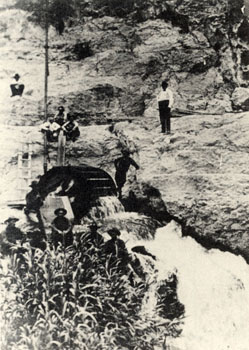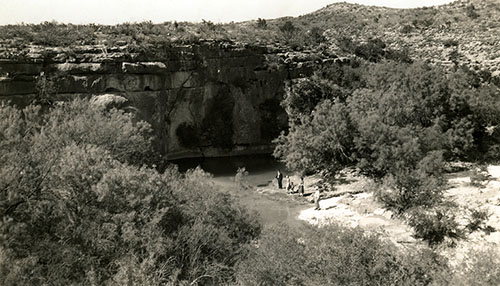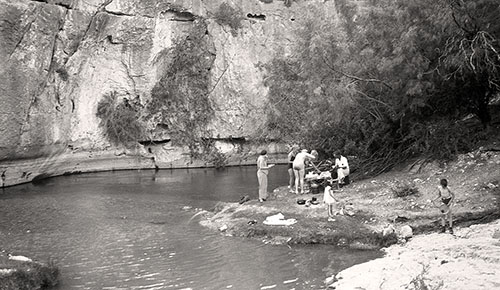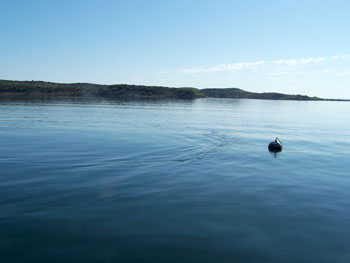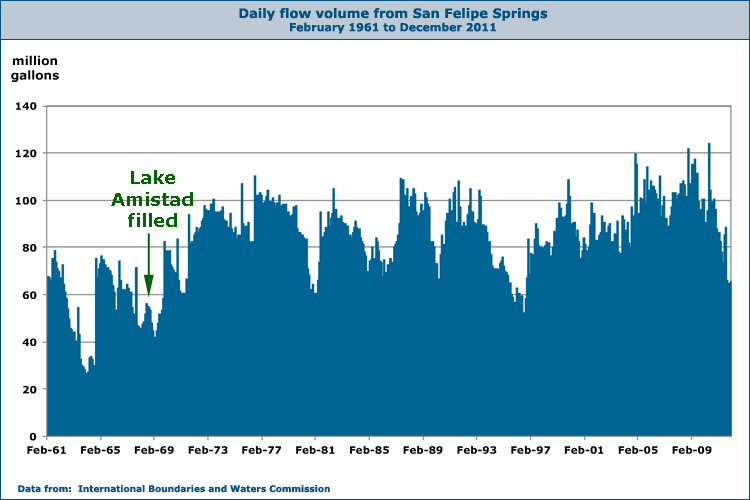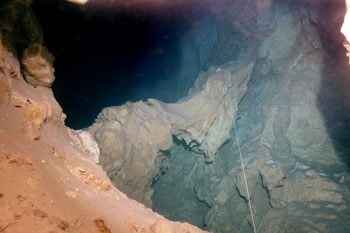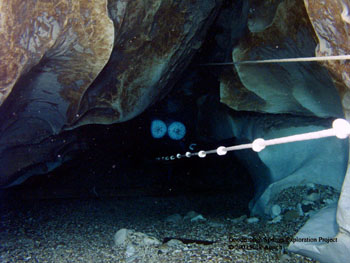
|
|
Goodenough Spring Goodenough Spring was once the third largest spring in Texas with an average annual discharge of 89 million gallons per day. It was also called Hinojosa Spring. In the early 1900s John Kelly built a water wheel that pumped some of the Spring's waters to the top of a nearby bluff for irrigation. The opening was at the base of a limestone ledge on what is now the northeast side of Lake Amistad. The Spring was inundated in 1968 by the filling of the Lake and is now under about 150' feet of water.
With the springs now under 150' feet of water, Lake Amistad places about 65 pounds of pressure on the Spring outlet, and it is believed this hydraulic head has somewhat reduced the artesian springflow. In the winter, when the Spring water is warmer than the Lake water, Brune (1981) noted that it rises to the surface and produces a smooth area, devoid of waves. It also often brings up sediment from the Lake bottom, creating a turbid area on the surface. Kamps and Groeger (2006) noted the mixing of Goodenough Spring water with the more saline waters of the reservoir is not uniform. They tracked winter Spring flows from a moving boat and observed the same surface infusion seen by Brune. In the summer, however, the Lake is strongly stratified and Spring waters form horizontal lenses beneath the surface. They believe that Goodenough Spring and other smaller springs around the Lake collectively have a diluting effect; without them, Lake Amistad waters would probably tend to be too salty for human consumption or agricultural use.
Effect of Lake Amistad In Springs of Texas, Brune asserted that the hydraulic head placed on Goodenough Spring by the filling of Lake Amistad had diverted more flow to other springs such as San Felipe, but he did not really provide supporting data or scientific evidence. In 2005, a report by LBJ-Guyton Associates for the Plateau Regional Water Planning Group pointed out there were obvious increases in flows at San Felipe Springs after Goodenough Spring was submerged (Guyton & Associates, 2005). It seemed that causation was implied in the report, but it was not directly stated. The chart below shows that flows at San Felipe have indeed been consistently higher since the Lake was filled. Before 1968, the average recorded flow was 51.7 million gallons per day, and from 1969 to June 2009 the flow averaged 79.8 million gallons per day. However, there are only seven years of data available before the Lake was filled, so from this data it's difficult to say conclusively that higher flows seen since 1969 have been caused by filling Lake Amistad and not some other variable like long-term weather trends. Research scientist Ray Kamps has pointed out that modern potentiometric surface maps of the area clearly show that the additional flow to San Felipe Springs is coming from the north and not the west. So at this time, there does not seem to be any real evidence that a significant part of the flow from Goodenough Spring is being diverted to San Felipe Springs.
Spring or Springs? Among the citizens and scientists who study and are interested in Goodenough Spring, there is a friendly debate about whether the proper term to use is "spring" in the singular sense, or the plural form "springs". It is written both ways in federal records and in many other documents. To have a single Edwards spring opening is very unusual. All of the other Edwards springs occur in groups, usually with several large openings and many small springs and seeps in the immediate vicinity. At San Antonio Springs, for example, there are literally thousands of small springs within a mile or so of the main opening. With Goodenough Spring, there is only one obvious opening. Veteran diver Chuck Noe reports that after nine years of poking around in every nook and cranny he has not seen any opening other than the main tunnel, and he doesn't believe another opening exists. There are also other indicators that Goodenough is not a typical Edwards spring. Noe points out that Goodenough discharges water of a much different character than other Edwards springs in the area; most notably, it is considerably warmer, indicating the source is much deeper. Goodenough Spring explorations In 2003 a group of technical divers from Houston formed the Goodenough Springs Exploration Project (GSEP) and have worked to map the cave and establish a cooperative scientific effort with the educational and governmental communities. They marked the location with a buoy and enhanced the site with guidelines and signage in accordance with cave-diving agency standards. The site is open to the public, but the GSEP cautions that Goodenough Spring is one of the most dangerous underwater caves in the world, and no amount of training and experience can prepare you for it. The cave poses all manner of hazards, including torrential currents, tight restrictions, temperature extremes, and entanglements. Safe diving can only be conducted through a careful incremental introduction to the cave and its environment. In July of 2008 GSEP divers successfully penetrated the cave to a depth of 515 feet, confirming Goodenough Spring as the deepest explored underwater cave system in the United States. Dive photos provided by the Goodenough Springs Exploration Project
|
||||||||||||||||||||||||||||||||||||
